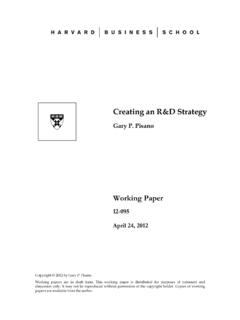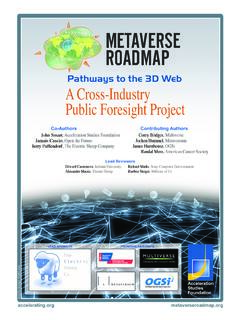Transcription of Strategic Leadership Primer: 3rd Edition
1 :ftl ~ ~f Deparbnent of Command, Leadership , and Management ~ Unili!d Slates Army War College ~ 2010 Department of Command, Leadership and Management United States Army War College Carlisle Barracks, PA 17013-5050 3rct Edition edited by Colonel (Ret) Stephen J. Gerras, Professor of Behavioral Sciences This Primer is the result of several years of research by the faculty of the Department of Command, Leadership , and Management. Please forward comments to Dr . Steve Gerras, Box 406 (phone: 717-245-3571). TABLE OF CONTENTS Preface to 3rd Edition ii Chapter 1 Introduction 1 Chapter 2 The Strategic Leadership Environment 9 Chapter 3 Vision 20 Chapter 4 Strategic Leader Competencies 28 Chapter 5 Strategic Decision Making Paradigms 35 Chapter 6 Strategic Leadership Tasks 48 Chapter 7 The Strategic Leader and the Human Dimension of Combat 55 Appendix A Strategic Leadership Competencies Monograph 58 i
2 PREFACE TO 3rd Edition The original Edition of the Strategic Leadership Primer, published in 1998, served the U S Army War College (USAWC) well as a basic overview of Strategic Leadership Written by Dr Rod Magee with the assistance of several other faculty members, it was intended as an orientation reading for students arriving at the USAWC whose backgrounds were primarily in the tactical and operational field environment The Primer was useful because there was no other adequate work that described and defined Strategic Leadership in terms that could be understood and applied by USAWC students A 2nd Edition was published in 2004 and edited by Colonel (Ret)
3 Steve Shambach This 3rd Edition updates significant portions of the Primer, especially Chapters 1, 2, and 3 and also adds a chapter on decision making (Chapter 5) It is not that the nature of Strategic Leadership has changed drastically, rather this Edition preserves the salient features of the original editions It is updated with contemporary literature and examples to sustain the Primer s relevance The editor acknowledges the tremendous contributions of Colonel Murf Clark and Professor Charles Allen, along with editing assistance from Commander Traci Keegan and Dr Richard Meinhart, while also acknowledging previous Edition contributions from Dr Lenny Wong, Dr Craig Bullis, and Colonel (Ret)
4 George Reed ii CHAPTER 1 INTRODUCTION It became clear to me that at the age of 58 I would have to learn new tricks that were not taught in the military manuals or on the battlefield.
5 In this position I am a political soldier and will have to put my training in rapping-out orders and making snap decisions on the back burner, and have to learn the arts of persuasion and guile. I must become an expert in a whole new set of skills. George C Marshall General Marshall is alleged to have made this observation as he reflected upon his early years as Chief of Staff of the Army (CSA) in the beginning months of World War II Marshall apparently believed his previous education, training, and experience had not adequately prepared him for high-level Leadership 1 As the CSA, his success depended upon his ability to persuade influential people and organizations, both in and out of government, to employ their efforts on behalf of his vision of a winning wartime strategy and to mobilize the Army to make that strategy a reality General Marshall s particular insights in this matter support the belief that beyond the direct and organizational levels is a third level of Leadership .
6 The Strategic level This Primer is intended to set the stage for a greater understanding and more in-depth study of Leadership at the Strategic level the context, challenges, characteristics, and requirements of Strategic Leadership The purpose of this chapter is to provide an overview of Strategic Leadership General Marshall seems to have intuitively understood that the development of a national strategy and the force structure to execute that strategy required a complex decision making structure at the national and even international levels As CSA, Marshall collaborated with civilian leaders to develop a vast industrial war machine and coordinated among the allied nations to ensure unity of effort Since Marshall s time as CSA, the political complexity of these national and international decision making structures has continued to grow Therefore, to be effective in today s Strategic arena, senior military leaders and their staffs must understand the Nation s Strategic vision and how strategy is formulated As well, they must appreciate the environment and multiple cultures in which they will operate, the competencies they must develop.
7 And the tasks they must perform Bringing the sum of their intellect and experience to bear, they must conceive a positive vision of the future and work towards those stated ends by developing policies and strategies that allow the clear articulation of the corresponding ways and means In short, Strategic leaders must succeed in an environment marked by volatility, uncertainty, complexity, and ambiguity (VUCA) 1 Though the lines between these levels sometimes blur.
8 We distinguish the Strategic level of Leadership from the tactical and operational levels in order to better understand the unique roles and responsibilities of today s senior leaders At the turn of the 21st Century, discussions about the realities of military conflict in the Information Age have addressed the concept of the Strategic Corporal, claiming that the mandates of Strategic Leadership now have the potential to extend to the lowest levels of military organizations asserting that the most junior member s actions can have Strategic impact and implications This Primer asserts that this is very different from exercising Strategic Leadership yet, more than ever, every level of the organization must appreciate its responsibilities, functions and impacts at the Strategic level To accommodate this multi-level awareness requirement.
9 Strategic leaders have a responsibility to spread knowledge and values throughout their organizations by clearly communicating a vision, shaping climate, influencing culture, coaching, mentoring, teaching, and exemplifying appropriate behaviors So what is Strategic Leadership ? The USAWC has traditionally defined Strategic Leadership as: The process used by a leader to affect the achievement of a desirable and clearly understood vision by influencing the organizational culture, allocating resources, directing through policy and directive, and building consensus within a volatile, uncertain, complex, and ambiguous global environment which is marked by opportunities and threats.
10 Differing slightly from the USAWC version, in 2008 CSA General George Casey asserted: Strategic leaders guide the achievement of their organizational vision within a larger enterprise by directing policy and strategy, building consensus, acquiring and allocating resources, influencing organizational culture, and shaping complex and ambiguous external environments They lead by example to build effective organizations, grow the next generation of leaders, energize subordinates, seek opportunities to advance organizational goals, and balance personal and professional demands 2 Providing another perspective.








